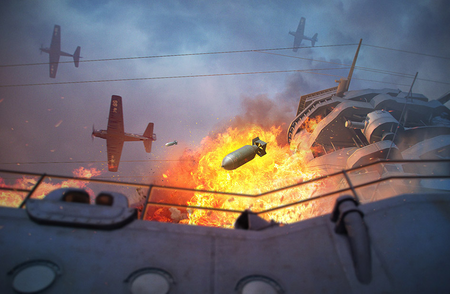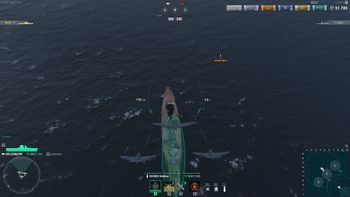User:AlphaDeltaEpsilon:na/Application_Temp
Bomb Types
Different bombers differ in bomb type and bomb quantity. The two types of bombs are high-explosive (HE) and armor-piercing (AP), and they differ in armor penetration, maximum damage, and fire chance.
Armor Piercing bombs are effective against armored targets, with the ability to do large amounts of citadel damage, but cannot start fires. High Explosive bombs are effective against all targets, and trade citadel potential for moderate damage and fire chance.
Like surface ships, fire chance can be increased by:
- The Victor Lima and India X-Ray flag signals (+1% each for bombs, +0.5% each for rockets)
- The "Demolition Expert" commander skill (+5% for bombs, +1% for rockets)
Usage
Bombers have two different attack patterns: dive and level. Most carriers in game carry dive bombers, which drop bombs during a high pitch dive. In contrast, British bombers deliver their payloads at high altitude, while remaining level. Finally, the unreleased Max Immelmann's skip bombers deliver skip bombs that bounce horizontally along the water.
Dive and level bombers, unlike attack aircraft or torpedo bombers, work best when attacking parallel to the ship. The bombsight shows why: like a ship, the dispersion pattern of a bomb is a long and narrow oval. Thus, regardless of bomb type, bombers should attack from the stern or the bow to maximize the chance of a successful hit.
The size of the sight depends on the aircraft's current speed, height, and pitch. Sight stabilization improves this aiming time. In addition, most dive bomber sights move relatively slowly during the initial climb and descent, but accelerate when approaching the target at the bottom of the dive.
High Explosive
High explosive bombs are the simplest, and have a constant penetration regardless of angle.
American (and Kaga's) dive bombers drop a moderate number of bombs during a dive, each dealing a moderate amount of damage with a decent fire chance.
British level bombers drop large numbers of lower-penetration bombs during horizontal flight. As a result, the dispersion ellipse is extended in the direction of the squadron's movement and is larger than that of other nations bombers. This allows for more hits and damage on a successful drop, as well as lower variance.
Armor Piercing
Japanese and German dive bombers drop a small number of high penetration AP bombs during a dive, with the possibility of scoring punishing citadels. However, like AP shells, AP bombs can only penetrate decks at certain angles.
An AP Bomb's angle of impact depends on pitch of the aircraft, which in turn depends on the point of drop. When the sight appears at a dive bomber's maximum height, bombs will impact approximately perpendicular to the deck. After that, the angle will decrease, as will the bomb's effective penetration.
An early bomb drop will cause that bomb to fall straight down, which is ideal against very thick armor. Bombs dropped at the last moment, when the dive is over and the aircraft parallel to the water, will hit at an angle, and allow the bomb to arm on thinly-armored targets. However, bombs dropped in that manner will ricochet off of thicker deck armor, like that found on certain battleships.
Once the bomb makes contact with armor, the usual AP shells mechanics will be used: normalization, ricochet check, armor penetration, and arming. Inside the ship, each encounter with armor reduces its speed and remaining penetration, until it eventually detonates, potentially dealing citadel damage.

